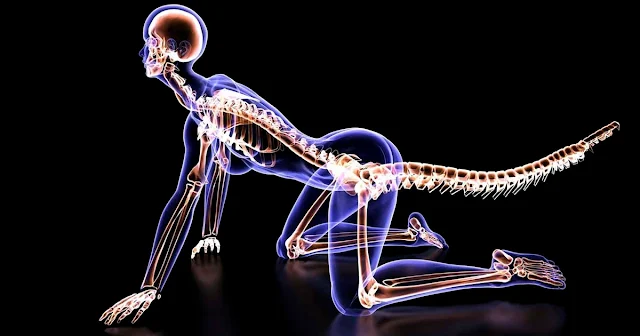One of the most remarkable changes in human evolution is the loss of our tails, a transformation that occurred around 25 million years ago. This pivotal shift not only altered the trajectory of our species but also marked a significant moment in the evolutionary history of primates. While scientists have long speculated on why humans lost their tails, the genetic cause has remained elusive—until now. A recent study published in Nature has finally uncovered the genetic factors responsible for this evolutionary change.

The Quest to Understand Tail Loss
The journey to unravel the mystery of human tail loss began in an unexpected way. Bo Xia, a graduate student at New York University, was inspired to investigate the origins of the human tailbone after injuring his own coccyx. This personal curiosity led Xia and his team to embark on a groundbreaking scientific investigation.
Through careful research, the team focused on the TBXT gene, which plays a crucial role in regulating tail length in various species. Their research revealed a unique genetic mutation within this gene, providing a major breakthrough in understanding human evolution.
The Role of Jumping Genes
A key aspect of this discovery lies in the role of Alu elements, often called “jumping genes.” These genetic elements, specific to primates, can move within the genome and cause significant changes. The researchers found that Alu elements inserted themselves into the TBXT gene, triggering a chain reaction that led to the loss of our tails.
This insertion activated a process known as alternative splicing, where RNA molecules are cut and restructured, which ultimately led to the deletion of a crucial exon. This change altered the structure and function of the resulting protein, leading to the tail loss seen in humans.
Validation Through Mice Studies
To confirm their findings, the researchers engineered laboratory mice with the same genetic mutations found in humans and apes. These genetically altered mice lost their tails, providing compelling evidence that the identified mutation plays a crucial role in the absence of tails in humans and other primates.
However, the study also uncovered a downside to tail loss: an increased risk of neural tube defects, such as spina bifida. This finding highlights the complex balance between evolutionary benefits and potential genetic trade-offs.
The Broader Implications
This discovery has profound implications not just for understanding human evolution, but also for human anatomy and health. The loss of our tails was not a random event but a genetic adaptation with lasting consequences. It illustrates the complex relationship between genetic changes and the way they shape our physiology over time.
As we continue to study our evolutionary past, these findings remind us of the intricate process of natural selection and genetic innovation that has shaped humanity. This breakthrough also underscores the power of scientific inquiry in uncovering the mysteries of our origins, offering insight into the past that can help us understand our future.
The identification of the genetic reasons behind tail loss is a testament to the persistence of scientific exploration and the ongoing quest for knowledge about our evolutionary journey.
At 15, Vivienne, Brad Pitt’s youngest daughter, is a little “Brangelina,” gorgeous.

Despite their short but lovely marriage coming to an abrupt end, Brad Pitt and Angelina Jolie had some amazing kids.
In addition to having the most famous double surname, Vivienne, 15, is the picture perfect daughter of picture-perfect parents and one of the most beautiful young women living. Her twin brother Knox and biological sister Shiloh share this surname.
Read on to learn more about the newest member of the Pitt-Jolie family!
Vivienne Marcheline Jolie-Pitt was born into an aristocratic Hollywood family and became well-known at an early age.
After the birth of their twins in 2008, Brad Pitt and Angelina Jolie, anticipating a circus of media attention, took control of the situation and sold People and Hello! the rights to the kids’ earliest photos! They donated the $14 million they collected from the sale of the images to their organization, the Maddox-Jolie-Pitt Foundation.
In a 2008 Rolling Stone interview, Brad Pitt talked about how the paparazzi invaded their personal lives, stating, “Well, we get run out of every major city.” That’s the cause of my b****ing. These photographers are pursuing the kids as they call out their names.
All eyes were focused on the couple and their growing family, though.

At the age of fifteen, Vivienne Marcheline, who went by her mother’s name Angelina Jolie, is widely recognized as one of the most stunning young women in the world. She is the youngest of six children, with her twin brother Knox being a few seconds older.
Given how stunning her parents are, it should come as no surprise that their children share their beauty.
Her father, a good-looking 60-year-old, is one of the only two men to have won People’s Sexiest Guy Alive twice, along with George Clooney and Johnny Depp. Numerous times, her mother has been named the world’s most beautiful woman.
In 1990, a young man from Missouri started to change Hollywood. His charming grin, bleached blonde hair, and innate acting abilities captivated every scene.
His perfectly sculpted features and dimples make him incredibly attractive to women. All he needed to win their hearts was a cowboy hat and a seductive sequence starring Geena Davis from the 1991 film Thelma and Louise.
Whether he plays a vicious psychopath in Kalifornia, an assassin in Bullet Train, or a kind-hearted blood sucker in Interview with the Vampire, Pitt never fails to captivate an audience that can’t get enough of him.

Pitt and Jennifer Aniston were one of the most alluring couples in Hollywood in the early 2000s, so many fans were devastated when they announced their divorce in 2005.
Only one month after Aniston filed for divorce, there were reports that the 48-year-old Mr. and Mrs. Smith actress and the Once Upon a Time star were dating.
Although the exact cause of Aniston and Pitt’s breakup remains unknown to the public, the Tomb Raider actress insists that the two were not intimate until Pitt’s divorce was finalized.
“To be intimate with a married man, when my own father cheated on my mother, is not something I could forgive,” she said, alluding to her father’s adultery. Her father is the well-known actor Jon Voight, who played Angelina Jolie’s father in the Lara Croft: Tomb Raider movie from 2001. She continued, saying, “I could not look at myself in the morning if I did that.” I would not be interested in a man who had an affair with his wife.

The couple’s biological kid Shiloh was born in 2006, and they were married in 2014, together with Knox and Vivienne. The family also consists of three adopted children: Maddox Jolie-Pitt, 22, from Cambodia, Zahara Jolie-Pitt, 18, and Pax Thien, 19, from Vietnam.
The Tomb Raider star explained that every child has reaped tremendous benefits from having a cosmopolitan upbringing.
They’re genuinely amazing people, and I think their sheer quantity has greatly influenced one another. Not that I led anything, really. I’m resolved to not give any of her children the benefit of the doubt. I always tell the truth to my children. And I’m incredibly human when it comes to my kids,” Jolie previously told People.
There are six remarkably diverse people living in my house. I’m infatuated with all the different stages, feelings, and interests that children go through. From whence could you not be? It’s our responsibility to help them find their identity. You can’t learn who they are if you don’t actively grow alongside them, she added.

Furthermore, since their divorce in 2019, Jolie and the Oceans 11 actress have shared parental responsibilities for the children.
Vivienne
Jolie greeted her, “My mother comes to mind every time I see or say Vivienne’s full name.”
“I dare to say Viv is proving to resemble Ange in spirit, attitude, and physicality,” says Vivienne’s loving father. with regard to her character. She has the same grace as her mother.
The screen that she and her mother are using is the same one.
Vivienne costarred with her Oscar-winning mother as a young Princess Aurora in the 2014 film Maleficent. when he was five years old.
Jolie told Entertainment Weekly that she didn’t think Vivienne would be in the film and that she thinks parents should give their children the freedom to make their own decisions.
“Although they like coming on set and making brief cameos, our kids are not actors in our eyes. That’s not at all what Brad and I hope to accomplish. However, none of the other [performers], who were three and four years old, would come up to me. It had to be a child that liked me and didn’t run from my eyes, claws, or horns. It had to be Viv after all.
Although Vivienne is now assisting her mother in creating the Broadway musical adaptation of The Outsiders, which is scheduled to open in April 2024, her only performing credit to far is this one.
For the stage adaptation of the 1983 movie of the same name, Jolie’s daughter Viv acts as her assistant. Jolie told E! News that Viv “reminds me of my mother in that she isn’t focused on being the center of attention but in being a support to other creatives.” “She is very thoughtful and serious about it, and she works really hard to figure out how she can contribute to the theater.”
benevolent spirit
Apart from her hereditary endowments, Vivienne’s magnanimous disposition stems from her generous parents. In 2019, she was seen at a neighboring dog park in Los Angeles, where she was selling treats to raise money for a nearby rescue shelter.

As a passionate animal lover, Vivienne was devastated to hear in 2020 that her favorite bunny had passed away. Jolie spoke with Harper’s Bazaar on the loss and said,Following the death of Vivienne’s bunny during surgery, we adopted two cute but little rabbits with disabilities. They have to work in pairs. Because they are so gentle, it has been helpful to focus on their care for her at this time. And speaking of dogs, snakes, and lizards…
It’s amazing that the twins are fifteen years old, and it will be interesting to see what they decide to do with their lives.
What are your thoughts on this stunning family? Please share this article with others and let us know what you think so we can hear from them too!
If you enjoyed this story as much as I did, you should read Shiloh, Vivienne’s older sister!



Leave a Reply